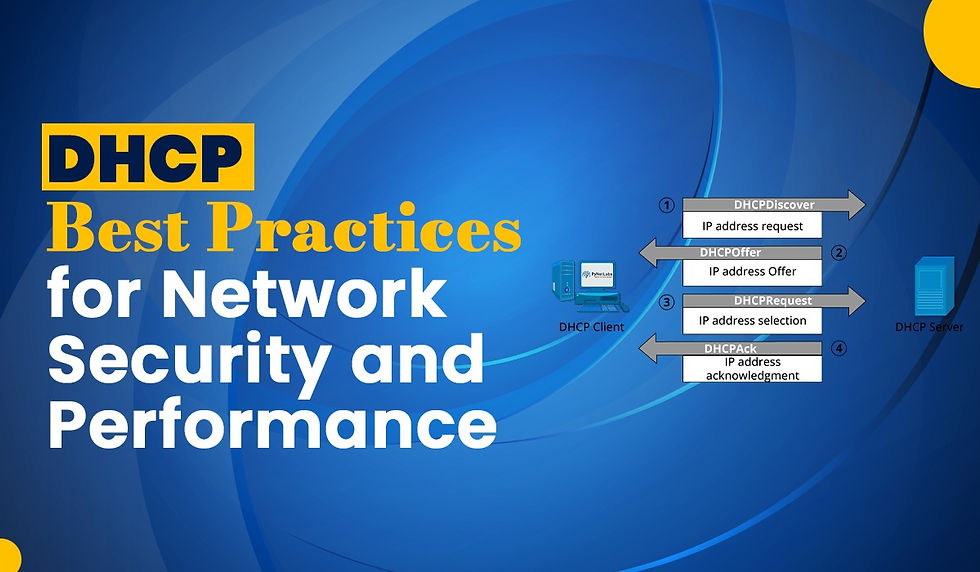DHCP Best Practices for Network Security and Performance
- seoaryan97
- Feb 1, 2024
- 5 min read

Introduction
Dynamic Host Configuration Protocol (DHCP) is an indispensable tool in network management. It serves as the linchpin for the automated assignment of IP addresses to devices within a network, significantly streamlining the entire process. As businesses and organizations grapple with complex network configurations, understanding the nuances of DHCP becomes pivotal. This protocol plays a crucial role in not just simplifying but also optimizing network setups, contributing to both security and performance.
Understanding DHCP Full Form
DHCP full form, or Dynamic Host Configuration Protocol, represents a paradigm shift in how networks handle IP address assignments. Unlike traditional static configurations, DHCP dynamically allocates IP addresses to devices, introducing an element of automation that is instrumental in reducing manual configuration errors and enhancing overall network efficiency.
How DHCP Works
At the heart of DHCP's functionality lies the intricate dance between the DHCP server and client. The server, responsible for dynamically assigning IP addresses, engages in a continuous dialogue with devices seeking network access. This dynamic allocation simplifies the network configuration process and ensures that IP addresses are assigned in a way that optimizes resource utilization and reduces conflict risk.
Benefits of DHCP Best Practices
Enhanced Network Security
Implementing DHCP best practices goes beyond mere operational efficiency; it actively contributes to bolstering network security. By adopting stringent configuration measures, DHCP servers can fortify themselves against potential security breaches and unauthorized IP allocations. This layer of security is imperative in today's digital landscape, where cyber threats are omnipresent.
Improved Network Performance
The optimization of DHCP configurations translates directly into enhanced network performance. Efficient allocation of IP addresses minimizes latency, ensuring that devices communicate swiftly and seamlessly. This not only improves the user experience but is also critical for applications and services that demand low latency, such as video conferencing or real-time data transfer.
Importance of Subnet in DHCP
Definition and Purpose of a Subnet
A subnet, in the context of DHCP, acts as a virtual segmentation of an IP network. Its primary purpose is to facilitate better organization and management of devices within a network. Subnets, when integrated with DHCP, play a pivotal role in ensuring that IP addresses are allocated intelligently, catering to the unique requirements of different network segments.
Subnetting for Efficient Network Management
Subnetting isn't just a technical nuance; it's a strategic approach to network management. By dividing a network into subnets, DHCP can allocate IP addresses in a more targeted manner, promoting efficient resource usage. This not only simplifies network administration but also lays the foundation for scalable and responsive networks.
Security Measures in DHCP
The security of DHCP servers is a paramount consideration in maintaining overall network integrity. Various measures, such as server hardening, robust authentication protocols, and continuous monitoring for unauthorized activities, form a comprehensive strategy to safeguard against potential security threats. A secure DHCP environment is crucial in preventing unauthorized access and potential breaches.
Performance Optimization in DHCP
Load Balancing for DHCP Servers
Load balancing is a key aspect of optimizing DHCP performance. By evenly distributing DHCP requests across multiple servers, organizations can prevent the overload of a single server, thereby ensuring consistent and efficient network operations. This not only enhances reliability but also contributes to a seamless user experience.
Reducing Network Latency
Efficient DHCP configurations play a pivotal role in reducing network latency. Swift responses to device requests ensure minimal delays in communication, which is particularly critical in scenarios where real-time data transfer or low-latency applications are in use. A low-latency network is synonymous with a high-performing network.
Common DHCP Issues
Address conflicts and server overload are challenges that organizations commonly face in DHCP environments. Addressing these issues promptly is not only a reactive measure but a proactive step toward maintaining a stable and reliable network. Resolving conflicts and managing server loads are integral components of DHCP maintenance.
Troubleshooting DHCP Problems
Efficient troubleshooting is an essential skill in the realm of network management. From verifying network connectivity to meticulously checking DHCP server logs, a step-by-step guide is provided for resolving common DHCP issues. This proactive approach ensures that potential problems are identified and rectified swiftly, minimizing downtime and disruption.
Best Practices for DHCP Configuration
Setting Lease Times
Configuring appropriate lease times for IP addresses is a nuanced aspect of DHCP management. Shorter lease times are suitable for dynamic environments where device connections frequently change, while longer lease times are more suitable for stable network configurations. Striking the right balance ensures efficient resource allocation.
Proper IP Address Allocation
The strategic allocation of IP addresses is a cornerstone of DHCP configuration best practices. Proper planning and consideration prevent inefficiencies, conflicts, and potential disruptions. An effective IP address allocation strategy contributes to the overall stability and reliability of the network.
Ensuring Redundancy in DHCP Setup
Importance of Backup DHCP Servers
Redundancy is a critical element in ensuring the uninterrupted operation of DHCP setups. Having backup DHCP servers in place acts as a safety net, stepping in seamlessly in the event of a primary server failure. This redundancy is a fundamental component of business continuity planning.
Failover Configurations for Uninterrupted Service
Failover configurations add an extra layer of reliability to DHCP setups. These configurations enable seamless transitions between DHCP servers, preventing service disruptions and downtime. Ensuring uninterrupted service is not just a best practice but a necessity in mission-critical environments.
DHCP and IoT Devices
The proliferation of the Internet of Things (IoT) has introduced new dynamics to DHCP management. The protocol plays a crucial role in dynamically managing IP assignments for the myriad of devices that constitute the IoT ecosystem. Security considerations become paramount in these scenarios to safeguard IoT networks from potential vulnerabilities.
Future Trends in DHCP
As technology evolves, DHCP is not exempt from innovation. IPv6 adoption in DHCP is on the horizon, addressing the ever-growing demand for IP addresses. Also, emerging technologies such as Software-Defined Networking (SDN) and artificial intelligence may usher in new configurations and practices in DHCP.
FAQs – Frequently asked questions
What is DHCP's role in network management?
DHCP dynamically assigns and manages IP addresses, simplifying network configuration. It plays a pivotal role in optimizing the allocation of IP addresses within a network.
How does DHCP contribute to network security?
DHCP best practices enhance security by preventing unauthorized access and mitigating potential breaches. Robust security measures, including server hardening and authentication, fortify DHCP servers against cyber threats.
What is the significance of subnetting in DHCP?
Subnetting in DHCP allows for efficient IP address allocation within specific segments of the network. It enhances organization and resource utilization, contributing to streamlined network management.
How can DHCP performance be optimized?
Performance optimization involves load balancing, reducing network latency, and configuring appropriate lease times. These measures collectively ensure a high-performing and responsive network.
Why is redundancy crucial in DHCP setups?
Redundancy, achieved through backup DHCP servers and failover configurations, ensures uninterrupted service and business continuity. It acts as a safety net in the event of primary server failures, minimizing downtime and disruptions.
Conclusion
In conclusion, the significance of DHCP best practices cannot be overstated in the context of modern network management. From fortifying security measures to optimizing performance and adhering to meticulous configuration strategies, businesses can ensure a robust and efficient DHCP environment. The amalgamation of these best practices contributes to not only the stability of networks but also the seamless operation of the myriad devices that rely on DHCP for dynamic IP address assignments.




Comments